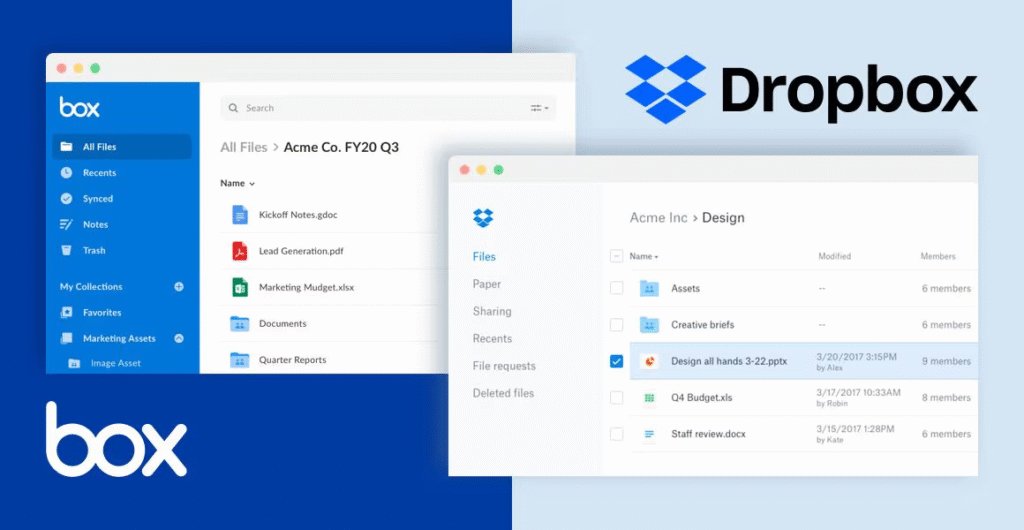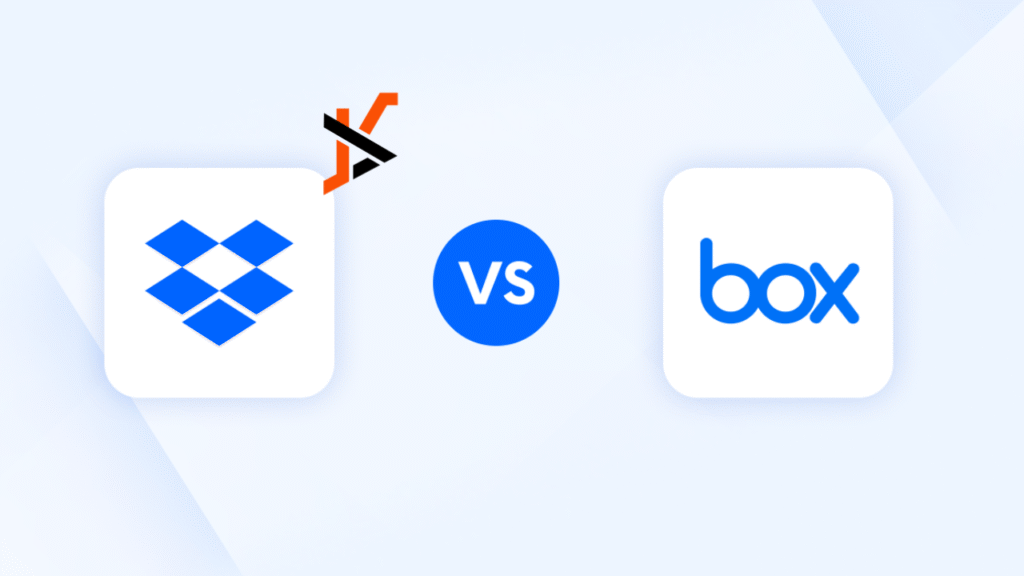When you’re looking for a place to keep your files safe, share them with friends, or work together on school or job projects, two names come up a lot: Dropbox and Box. They both help you store files online, but they’re not exactly the same. If you’ve been wondering which one to pick, this guide will break it down for you in plain, easy-to-understand language.
What Is Dropbox and What Is Box?
Dropbox is one of the earliest and most well-known cloud storage platforms. It lets you save your files online (“in the cloud”) so you can open them from your computer, phone, or tablet anywhere in the world. You can upload photos, videos, homework, work documents, or any other digital file. Dropbox also makes it easy to share files or folders with other people by sending them a link—no email attachments required.
Box, on the other hand, is also a cloud storage service but is often more popular with businesses and organizations. Like Dropbox, it lets you upload and access files online, but Box focuses a lot on secure file sharing, team collaboration, and integration with other work tools like Microsoft Office 365, Google Workspace, and Slack. While anyone can use Box, its extra features are often aimed at companies that need more control over who sees and edits their files.
Both services give you the same basic idea—store files online and share them—but the way they’re built and the extra tools they include can make one better for you depending on your needs.
Main Differences Between Dropbox and Box
The biggest differences between Dropbox and Box come down to who they’re designed for and what features they focus on.
- Audience focus: Dropbox is designed for both individuals and businesses, while Box is more business-oriented from the start.
- Collaboration features: Dropbox Paper (a note-taking and document tool) makes it easy for personal and small team projects. Box, however, has advanced permissions, workflows, and admin controls for larger teams and enterprises.
- Storage limits and pricing: Dropbox often offers more storage on its personal plans, while Box includes extra security tools even on lower-tier business plans.
- Integrations: Both work with popular apps, but Box has a heavier focus on enterprise software and security compliance.
If you’re looking for something quick and simple for personal use, Dropbox might feel friendlier right away. If your main goal is to collaborate with a team in a secure, controlled way, Box might be the better fit.
How Easy Are They to Use?
Both Dropbox and Box are pretty user-friendly, but their first-time setup and everyday tasks can feel slightly different. Let’s walk through the basics so you know what to expect.

Setting Up an Account
With Dropbox, creating an account is as simple as going to the website, typing in your name, email, and password, and you’re ready to go. They guide you through installing the app on your computer or phone so you can drag and drop files straight into your Dropbox folder.
With Box, the sign-up is also quick, but if you’re joining through a company or school account, you might have to go through an invitation link or a special login page. Box will also ask you to set up two-step verification early on, which makes your account more secure but adds an extra step.
Uploading Files
Dropbox makes uploading easy: you can drag files into the desktop folder, use the web interface, or upload from your phone. Files sync automatically, meaning changes you make in one place show up everywhere else.
Box works the same way, but it gives you more control over file permissions during upload. For example, you can upload a file and immediately set who can view, download, or edit it. This is great for teams but might feel like extra work if you’re just storing personal photos.
Sharing with Friends
Sharing in Dropbox is as easy as right-clicking a file and choosing “Share.” You can make a link that anyone can open or only share with certain people. If you pay for Dropbox Professional or Business, you can add passwords and expiration dates to shared links.
Box lets you do the same but adds even more detailed controls. You can set whether people can download, edit, or just view a file. Box also has “link access levels” that let you decide if the link is public, restricted to your company, or limited to specific people.
Dropbox vs Box for School or Work
If you’re in school, Dropbox might be easier because of its clean, simple design. You can keep all your homework, presentations, and group projects in one place without worrying about complicated settings. Dropbox Paper is also handy for taking notes or planning group work.
If you’re using it for work, Box may be the better choice—especially if you’re in a company that works with sensitive information. Box’s security tools and admin controls help teams follow strict data rules and keep private files safe. It also works well with project management tools and team chat apps.
Which One Is Safer for Your Stuff?
Both Dropbox and Box take security seriously. They encrypt your files, which means they scramble the data so only you (and anyone you share with) can read it. They also offer two-factor authentication, which adds an extra login step for safety.
Box, however, is known for going the extra mile with business-level security. It follows strict compliance standards like HIPAA (for healthcare) and FedRAMP (for government agencies). Dropbox is still very secure for personal and small business use, but Box might be the safer choice for organizations with high privacy requirements.
Free Plans – What Do You Get Without Paying?
Not everyone wants to pay for cloud storage right away. Both Dropbox and Box offer free versions so you can try them out before committing.

Dropbox Free Plan
Dropbox’s free plan, called Dropbox Basic, gives you 2 GB of storage. That’s enough for thousands of text documents or a few hundred photos. You get file syncing across devices, basic file sharing, and access to Dropbox Paper. It’s simple and works well for personal use, but 2 GB fills up quickly if you store large files like videos.
Box Free Plan
Box’s free plan gives you 10 GB of storage, which is more than Dropbox’s free option. However, Box limits the maximum file size you can upload at once to 250 MB. That means it’s better for many small files rather than huge videos. The free plan includes file sharing, syncing, and mobile access.
How Much Do They Cost If You Upgrade?
If you need more space or extra features, both Dropbox and Box offer paid plans. Dropbox’s personal paid plans start with 2 TB of storage, while Box’s cheapest paid plan often focuses on team collaboration features rather than huge storage jumps. Pricing can change, but generally, Dropbox’s personal plans are better for individual users, while Box’s paid tiers make more sense for teams or businesses.
The Bottom Line
When it comes to Dropbox vs Box, your choice depends on what you need:
- Choose Dropbox if you want an easy, beginner-friendly way to store and share personal files, school work, or small business documents.
- Choose Box if you need strong security, detailed sharing controls, and tools for large team collaboration—especially if you work in a business or organization with sensitive information.
Both services let you try them for free, so the best way to decide is to sign up for both, upload a few files, and see which one feels right for you.

